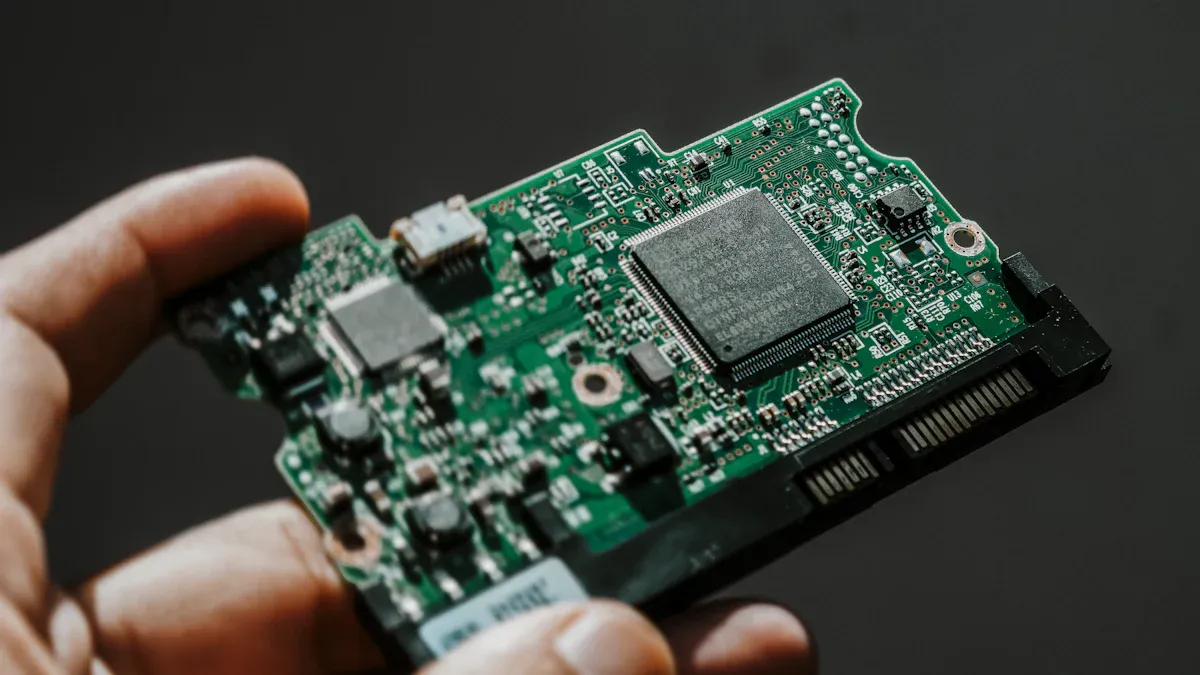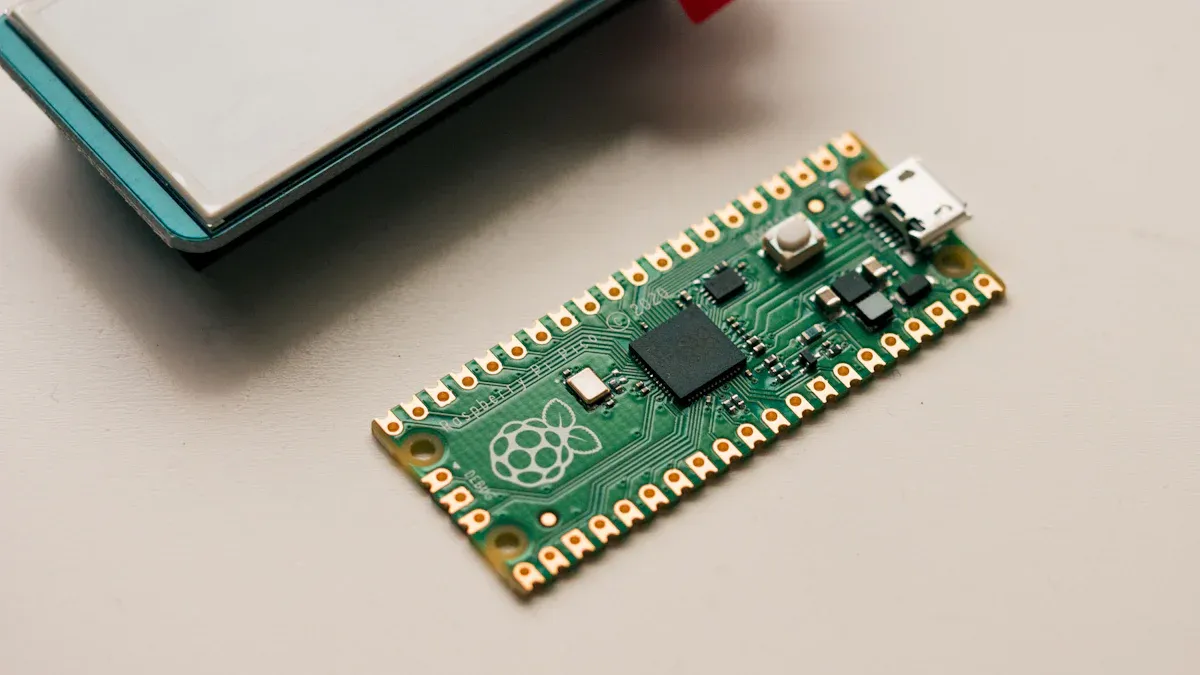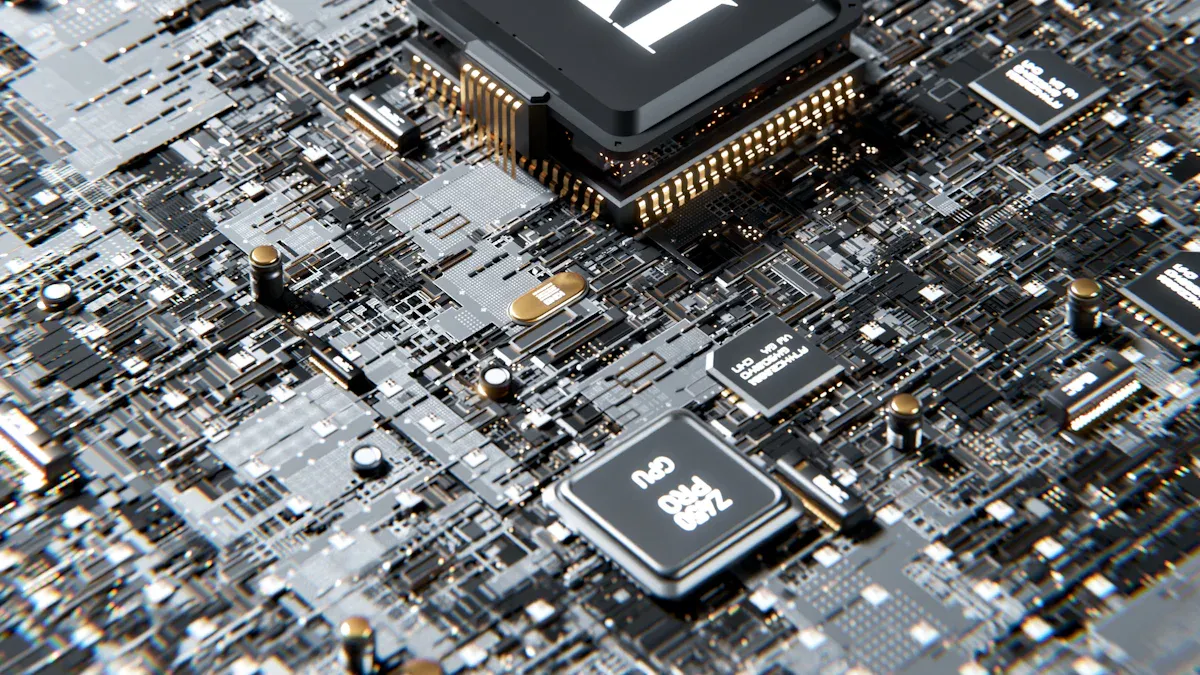What Are Industrial D Flash Microcontrollers and Their Applications

Industrial D Flash microcontrollers are specialized computing devices designed for industrial environments. They combine robust processing capabilities with D Flash memory, enabling efficient data storage and retrieval. You can rely on these microcontrollers to withstand harsh conditions like extreme temperatures or vibrations, making them essential in factories and automated systems. Their advanced features support real-time processing and low power usage, which drive innovation in industries like manufacturing and healthcare. By integrating an Industrial D Flash Microcontroller Mcu into your systems, you enhance performance and ensure long-term reliability.
Key Takeaways
Industrial D Flash microcontrollers work well in tough conditions. They are great for industries like factories and healthcare.
D Flash memory helps them save data during power cuts. It also uses less energy when not active.
These microcontrollers have strong security to keep data safe. They are used in important tools like medical devices and cars.
They can be scaled to fit different uses. This includes small IoT gadgets or big factory systems.
Using Industrial D Flash microcontrollers saves money. They need less fixing and make systems work better.
Understanding Industrial D Flash Microcontroller Mcu
Definition and Core Components
Industrial D Flash microcontrollers are specialized devices designed for demanding environments. They consist of a central processing unit (CPU), D Flash memory, input/output interfaces, and communication modules. The CPU handles instruction execution and real-time processing. D Flash memory stores data securely, even during power loss. Input/output interfaces connect sensors, actuators, and other peripherals, while communication modules enable data exchange between devices. These components work together to deliver reliable performance in industrial applications.
How D Flash Memory Enhances Microcontroller Functionality
D Flash memory plays a crucial role in improving microcontroller efficiency. It offers non-volatile storage, ensuring data retention without continuous power. This feature is vital for industrial systems that experience power fluctuations. Additionally, D Flash memory optimizes instruction execution, reducing the active time of the processor. Burst mode operation allows the processor to remain inactive for extended periods, lowering energy consumption.
Here’s a comparison of power consumption between D Flash memory and volatile memory:
Memory Type | Standby Power Consumption | Active Power Consumption |
|---|---|---|
D Flash Memory | Reduced | High due to programming |
Volatile Memory | Higher | Lower |
By integrating D Flash memory, you enhance overall system performance and energy efficiency.
Key advantages include:
Long-term data retention without external power.
Reduced energy usage during inactive periods.
Improved reliability in critical applications.
Differences Between Industrial and Standard Microcontrollers
Industrial microcontrollers differ from standard ones in several ways. They are designed to operate in harsh conditions, such as extreme temperatures, vibrations, and electromagnetic interference. Standard microcontrollers lack this level of durability. Industrial models also feature advanced security measures to protect sensitive data, while standard devices often have basic security protocols.
Another key distinction lies in scalability. Industrial D Flash microcontrollers can adapt to diverse applications, from manufacturing automation to medical devices. Standard microcontrollers are typically limited to simpler tasks. By choosing an industrial model, you gain access to robust functionality tailored to complex environments.
Key Features of Industrial D Flash Microcontroller Mcu

High Reliability in Harsh Environments
Industrial D Flash microcontrollers excel in environments where standard devices fail. You can rely on them to operate under extreme temperatures, vibrations, and even radiation. These microcontrollers meet rigorous certifications like MIL-STD and MIL-PRF, which verify their performance in demanding conditions. For example:
Military standards ensure they function reliably in high-temperature and high-radiation environments.
Infineon’s products, qualified to ESA and DLA standards, are used in aviation, defense, and space applications.
A statistical model for SRAM-based FPGA designs further highlights their reliability. This model considers single-bit and multiple-cell upsets, offering a 95% confidence interval for accuracy. Such innovations reduce development costs and ensure dependable performance.
Advanced Data Retention and Security
Data retention and security are critical in industrial systems. Industrial D Flash microcontrollers store data reliably, even during power interruptions. This feature ensures your systems maintain functionality without data loss. Additionally, these microcontrollers incorporate advanced security protocols to protect sensitive information.
For example, QML Class Q certification guarantees high-reliability standards for military applications. Components undergo stringent testing, including Radiation Hardness Assurance (RHA), to ensure data integrity in harsh conditions. By using these microcontrollers, you safeguard your systems against both environmental and cyber threats.
Real-Time Processing and Low Power Usage
Industrial D Flash microcontrollers deliver real-time processing while minimizing energy consumption. Tools like the EEMBC ULPBench validate their energy efficiency, providing reliable benchmarks. Specialized neural processing units (μNPUs) further enhance performance by reducing latency and power usage during neural network inference.
These microcontrollers also optimize energy use through features like burst mode operation. This allows the processor to remain inactive for extended periods, conserving power. By integrating an Industrial D Flash Microcontroller Mcu, you achieve both high-speed processing and energy efficiency, making it ideal for modern industrial applications.
Scalability for Diverse Applications
Industrial D Flash Microcontroller Mcu offers exceptional scalability, making it suitable for a wide range of applications. You can adapt these microcontrollers to meet the needs of industries like manufacturing, healthcare, and energy management. Their modular design allows you to scale systems up or down, depending on the complexity of your project.
A case study on scalable intelligence in AIoT domains highlights their versatility. It examines two practical applications: remote building control and surveillance, and mining. These examples demonstrate how Industrial D Flash Microcontroller Mcu supports speed, reliability, and security in mobile environments. The study also identifies key factors that influence scalability:
Conversion efficiency.
Cost of deployment.
Delay needed for control.
Scalability.
Computational complexity.
These factors ensure that you can implement these microcontrollers in both small-scale and large-scale systems. For instance, in remote building control, they enable efficient energy management by processing data from multiple sensors. In mining, they enhance safety by providing real-time monitoring of equipment and environmental conditions.
The ability to handle diverse workloads makes these microcontrollers a valuable asset. You can use them to optimize performance in IoT devices, industrial automation, and even medical equipment. Their scalability ensures that your systems remain future-proof, adapting to new challenges and technologies with ease.
Tip: When choosing a microcontroller, consider its ability to scale with your application’s growth. This ensures long-term efficiency and cost-effectiveness.
Benefits of Industrial D Flash Microcontroller Mcu
Enhanced System Performance and Efficiency
You can achieve significant improvements in system performance and efficiency by implementing Industrial D Flash Microcontroller Mcu. These microcontrollers optimize data handling and processing, ensuring smooth operation even under demanding workloads. Their advanced memory technology reduces wear and tear, which enhances endurance and reliability.
Here’s a breakdown of measurable performance improvements:
Metric Description | Measurement | Implication |
|---|---|---|
Measured in erasures per 64 KB | Lower erasures correlate with higher endurance | |
Reclamation efficiency | Ratio of user data to total data | A ratio close to 100% indicates high efficiency |
Endurance under different workloads | Endurance percentages for file states | Above 75% is good; below 50% is poor |
These metrics demonstrate how these microcontrollers enhance system efficiency while maintaining durability. By reducing data erasures and improving reclamation efficiency, you ensure your systems operate at peak performance for longer periods.
Cost-Effectiveness Through Reduced Maintenance
Industrial D Flash Microcontroller Mcu minimizes maintenance costs by offering exceptional durability and reliability. You won’t need frequent replacements or repairs, as these microcontrollers are designed to withstand harsh conditions. Their ability to retain data during power interruptions reduces the risk of system failures, saving you time and resources.
For example, their advanced memory technology ensures fewer write cycles, which extends the lifespan of the microcontroller. This durability translates to lower operational costs over time. By investing in these microcontrollers, you reduce maintenance expenses and improve the overall cost-effectiveness of your systems.
Longevity and Safety in Critical Applications
When you use Industrial D Flash Microcontroller Mcu in critical applications, you ensure both longevity and safety. These microcontrollers are built to last, even in extreme environments. Their robust design protects against temperature fluctuations, vibrations, and electromagnetic interference.
In safety-critical systems, such as medical devices or automotive controls, reliability is non-negotiable. These microcontrollers provide consistent performance, ensuring the safety of users and equipment. Their advanced security features also protect sensitive data from cyber threats, adding an extra layer of safety. By choosing these microcontrollers, you create systems that are both durable and secure, meeting the highest standards of reliability.
Applications of Industrial D Flash Microcontroller Mcu

Manufacturing and Industrial Automation
You can use Industrial D Flash Microcontroller Mcu to revolutionize manufacturing and industrial automation. These microcontrollers enable precise control of machinery, ensuring smooth and efficient operations. Their ability to process real-time data allows you to monitor equipment performance and detect issues before they escalate.
For example, in a factory setting, these microcontrollers can manage robotic arms, conveyor belts, and assembly lines. They process input from sensors and adjust operations instantly, maintaining high productivity. Their scalability also makes them suitable for both small-scale workshops and large industrial plants.
Key benefits in manufacturing include:
Improved efficiency: Real-time processing reduces downtime and optimizes workflows.
Enhanced safety: Advanced security features protect systems from cyber threats.
Cost savings: Reduced maintenance needs lower operational expenses.
By integrating these microcontrollers, you can achieve higher output quality and streamline your production processes.
Automotive Systems and Transportation
Industrial D Flash Microcontroller Mcu plays a vital role in modern automotive systems and transportation technologies. These microcontrollers simplify system design by integrating into System-on-Chip (SoC) architectures. This trend has led to the replacement of external MCUs with integrated solutions, making vehicles smarter and more efficient.
In electric vehicles (EVs), you can rely on these microcontrollers to manage battery systems, monitor energy usage, and optimize charging processes. They also enhance safety features like anti-lock braking systems (ABS) and airbag deployment by processing sensor data in real time.
Public transportation systems benefit as well. For instance, these microcontrollers enable real-time tracking of buses and trains, improving scheduling and reducing delays. Their low power consumption ensures reliable performance in energy-sensitive applications.
Did you know? The automotive microcontroller industry is shifting toward integrated solutions, highlighting the growing importance of these devices in transportation technologies.
By adopting these microcontrollers, you contribute to safer, more efficient, and environmentally friendly transportation systems.
Energy Management and Smart Grids
You can use Industrial D Flash Microcontroller Mcu to transform energy management and smart grid systems. These microcontrollers process data from sensors and meters, enabling real-time monitoring of energy usage. This helps you identify inefficiencies and optimize energy distribution.
In renewable energy systems, such as solar panels and wind turbines, these microcontrollers manage power generation and storage. They ensure that energy flows seamlessly between sources, storage units, and the grid. Their advanced data retention capabilities also safeguard critical information during power outages.
Smart grids benefit significantly from these microcontrollers. They enable two-way communication between energy providers and consumers, allowing for dynamic load balancing. This reduces energy waste and enhances grid reliability.
Key advantages in energy management include:
Sustainability: Optimized energy usage reduces environmental impact.
Cost-effectiveness: Improved efficiency lowers energy bills.
Reliability: Real-time monitoring prevents system failures.
By implementing these microcontrollers, you can create smarter, greener, and more resilient energy systems.
Medical Devices and Healthcare Equipment
Industrial D Flash Microcontroller Mcu plays a transformative role in medical devices and healthcare equipment. These microcontrollers enable real-time data processing, secure communication, and efficient power usage, making them indispensable in modern healthcare systems. You can rely on them to enhance patient monitoring, diagnostic accuracy, and overall system reliability.
For instance, microcontrollers like the ESP32 and STM32 are widely used in healthcare applications due to their advanced features. Here’s a comparison of some popular microcontrollers and their roles in healthcare:
Microcontroller | Key Features | Role in Healthcare Applications |
|---|---|---|
ESP32 | Dual-core architecture, integrated Wi-Fi and Bluetooth, ultra-low power | Ideal for remote patient monitoring with real-time data transmission. |
STM32 | ARM Cortex-based, high computational efficiency, low power consumption | Suitable for embedded medical applications requiring real-time processing of ECG signals. |
Raspberry Pi | High processing power, versatile I/O capabilities | Enables real-time preprocessing of biomedical signals and anomaly detection. |
ATmega2560 | 256 KB flash memory, multitasking capabilities | Supports extensive firmware storage and real-time data collection in health monitoring applications. |
Arduino Mega Board | 54 digital I/O pins, 16 analog inputs | Facilitates integration with multiple biomedical sensors for real-time physiological signal interpretation. |
These microcontrollers power systems like the Monit4Healthy platform, which integrates high-performance microcontrollers for real-time health monitoring. This system enhances sensor interoperability and ensures secure data exchange, addressing critical challenges in connected healthcare ecosystems. By adopting these technologies, you can improve patient outcomes and streamline healthcare operations.
Tip: When selecting a microcontroller for medical applications, prioritize features like low power consumption, real-time processing, and secure communication to ensure optimal performance.
IoT and Consumer Electronics
The rise of IoT and consumer electronics has significantly increased the demand for Industrial D Flash Microcontroller Mcu. These microcontrollers provide the processing power and energy efficiency needed to support smart devices, wearables, and home automation systems. You can use them to enable seamless connectivity, real-time data processing, and enhanced user experiences.
Market trends highlight the growing adoption of these microcontrollers. The global microcontroller market is projected to grow from $24.74 billion in 2024 to $27.66 billion in 2025, with a compound annual growth rate (CAGR) of 11.8%. By 2029, the market size is expected to reach $44.88 billion, growing at a CAGR of 12.9%. This growth is driven by the increasing demand for consumer electronics and electric vehicles.
In IoT applications, these microcontrollers enable devices to communicate efficiently while conserving energy. For example, smart thermostats use them to process temperature data and adjust settings in real time. In consumer electronics, they power devices like smartwatches and fitness trackers, ensuring accurate data collection and extended battery life.
Did you know? The number of battery-only electric passenger cars in the EU increased from 1.9 million in 2021 to 3 million in 2022, marking a 55% growth. This surge reflects the growing reliance on microcontrollers in energy-efficient technologies.
By integrating Industrial D Flash Microcontroller Mcu into your IoT and consumer electronics projects, you can create innovative, reliable, and energy-efficient solutions that meet the demands of modern consumers.
Industrial D Flash Microcontroller Mcu stands out as a cornerstone of modern industrial systems. You’ve seen how its robust features, like high reliability and advanced data retention, make it indispensable in harsh environments. Its applications span industries, from healthcare to energy management, showcasing its versatility. By adopting this technology, you drive innovation and improve efficiency in your operations. As industries evolve, these microcontrollers hold immense potential to shape future advancements, ensuring smarter, safer, and more sustainable systems.
FAQ
What is the primary advantage of using D Flash memory in microcontrollers?
D Flash memory ensures data retention even during power loss. This feature makes it ideal for industrial systems where power interruptions occur. It also reduces energy consumption by allowing the processor to remain inactive for longer periods.
How do Industrial D Flash Microcontrollers differ from regular microcontrollers?
Industrial microcontrollers withstand harsh conditions like extreme temperatures and vibrations. They also offer advanced security features and scalability for complex applications. Regular microcontrollers lack these capabilities and are better suited for simpler tasks.
Can Industrial D Flash Microcontrollers be used in IoT devices?
Yes, these microcontrollers are perfect for IoT devices. They provide real-time data processing, low power consumption, and secure communication. These features make them ideal for smart homes, wearables, and other connected technologies.
Are Industrial D Flash Microcontrollers cost-effective?
Absolutely. Their durability and reliability reduce maintenance costs over time. They also optimize energy usage, which lowers operational expenses. By investing in these microcontrollers, you save money while improving system performance.
What industries benefit the most from Industrial D Flash Microcontrollers?
Industries like manufacturing, healthcare, automotive, and energy management benefit greatly. These microcontrollers enhance efficiency, ensure safety, and support real-time monitoring. Their versatility makes them valuable across diverse applications.
Tip: When selecting a microcontroller, consider your industry’s specific needs to maximize its benefits.
See Also
Exploring Industrial Control Chips and Their Role in Automation
Defining High-Performance Microcontroller Integrated Circuits Explained
Exploring Applications of Single Darlington Transistor IC Chips
Insights into Low Power IoT Chip Technologies and Uses
Exploring Battery Charger Controller ICs and Their Functions
